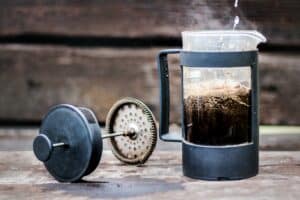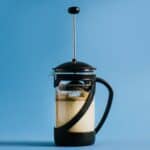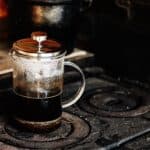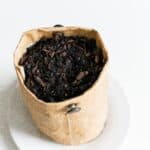How to Use a French Press Properly (Step By Step Guide)

Table of Contents
ToggleA French press is a humble, but well loved coffee brewing device that is used all over the world. However, many people don’t get the best results out of their French Press (or cafetiere as it is often referred to) as the proper technique is not often discussed.
In this article, I will break down what exactly a French press is, where it came from and how you can make delicious coffee with yours every single time! I’ll also disclose some little known top tips, so you can take your everyday french press and turn it into a coffee connoisseur’s dream!
What is a French Press?

A french press is a coffee brewing device that uses a mesh strainer and plunger to separate ground coffee from your cup. Coarsely ground coffee beans and boiling water are added to the glass container, and the mesh plunger slides down into the glass, acting as a strainer so no ground coffee ends up in the serving cup.
A french press is a very simple device to operate, thanks to its lack of parts! All you need is ground coffee, boiled water and the french press itself. No filter papers or fancy gooseneck kettles required!
Where Did the French Press Come From?
Let’s take a closer look at the origins of the French press. The name suggests that the device originated in France, but given the rich history of Italian coffee culture, it may not surprise you to hear the original French press design was patented by an Italian!
According to Perfect Grind Daily’s article from May 2015 “French Press – The History & Brewing Guide” the French press patents were tossed between French and Italian designers for a century!
The first rudimentary design was created by two Frenchmen, (Delforge and Mayer) in the mid 1800s. This device used a cheesecloth to strain out coffee grounds and produce the delicious brewed coffee we know today. However, in the 1920s, two Italians (Calimani and Montea) came up with a more advanced design and patented it.
However, it was the 1950s version of the French press that really stuck. The Swiss designer Bondanini produced a French press that resembles what we all use today. This gained popularity in France and was called a ‘Chambord’, and was then marketed to wider markets as ‘La Cafetiere’. It was this popularity in France that gave the French Press its name, despite its design cues being developed by Italinas and Swiss!
Different French Press Types
Now we’ve discussed the history of the French press, let’s take a closer look at some different types you can buy.
Sizes
The first decision to make when you’re deciding which type of French press to buy is how big you need it! Obviously this depends on how many people you are likely to brew for, but the most common French press sizes are:
- 3 Cup/350ml/12 oz (approx 1.5 mugs)
- 4 Cup/500ml/18 oz (approx 2 mugs)
- 6 Cup/700ml/24 oz (approx 3 mugs)
- 8 Cup/1L/36oz (approx 4 mugs)
- 12 Cup/1.5L/48 oz (approx 6 mugs).
Double Walled
Double walled french presses are perfect for when you need to keep your coffee hot for extended periods of time. The air in between the walls means your coffee will be well insulated and stay warm for 4 to 5 times longer than a single walled French press.
Double walled French presses come in both glass and metal construction.
Metal vs Glass
Most French presses you’ll find on the market feature a glass body and a plastic and metal strainer. However, French presses can also be made completely out of metal for a more classy, upmarket finish.
Brushed aluminium, stainless steel and copper are common materials used for French presses, so look out for them too!
Electric French Press
If boiling a kettle and stirring up your coffee sounds like too much work, you can always buy an electric French press! These self heading devices are great if you want to pop your brew on and leave it to sit whilst you do something else!
Buy your own Electric French Press on Amazon Here!
How to Use a French Press: Step by Step

So, the moment you’ve been waiting for.
Here is a simple, step by step guide of how you can make delicious coffee in your French press from the comfort of your own home!
Step 1: Grind Your Coffee Beans
The coffee beans you choose for your French press are completely up to you. There is no right or wrong answer, but I tend to find that a medium roast Arabica strikes a good balance between strength, body and distinct flavour notes.
Some people say you should use a lighter roast for French press, and some say a darker roast is more preferable. In reality, the dose and grind size of your coffee beans will make a bigger difference to the overall taste than the roast of the bean used.
A medium to coarse roast tends to work best for French press brewing. This is because the method uses immersion as opposed to percolation brewing, in which all the coffee grounds and water mingle together to gradually extract the coffee throughout the brew time.
If you grind your coffee too fine for a French press, you’ll end up with over extracted, bitter tasting coffee. And no one wants that!
Step 2: Boil Your Kettle
Once you have ground your coffee beans, simply boil your kettle so you have plenty of hot water to fill up your French press.
Step 3: Measure Out Your Ground Coffee and Add to French Press
Whilst your kettle is boiling, it is time to measure out your ground coffee ready for your French press brew.
Coffee to water ratios are often debated in the coffee world, no matter which brewing method you’re using!
However, as far as the French press goes, a good rule of thumb to follow is approx 2 level tablespoons (30g/) of ground coffee, and 9oz (250ml) per 2 cups (1 mug) of brewed coffee.
Of course, the weight of your coffee will vary depending on the roast you choose, and not everyone’s tablespoons are the same size! So, play around with different ratios of coffee to water and see what suits you best! However, a good ratio to go by for coffee to water for French press is a 1:16 combination.
Here is a table giving you a bit more information of how much coffee and water you should use to brew a perfectly balanced cup of coffee with your French press:
| Quantity of Brewed Coffee Required | Amount of Ground Coffee Needed | Amount of Water Needed | French Press Size |
| 1 Mug (2 Cups/250ml/8oz) | 16g/2 Tablespoons/0.5oz | 250ml/8oz/2 Cups | 8oz |
| 2 Mugs (4 Cups/500ml/18oz) | 32g/4 Tablespoons/1oz | 600g/18oz/4 Cups | 18oz |
| 4 Mugs (8 Cups/1 L/36oz) | 64g/8 Tablespoons/2.25oz | 1kg/36oz/8 Cups | 36oz |
| 6 Mugs (12 Cups/1.5L/48oz) | 130g/12 Tablespoons/4.5oz | 1.4kg/48oz/12 Cups | 48oz |
Step 4: Add Your Hot Water
Once you have determined the right amount of coffee and water to use, it is time to combine these ingredients together so you can make the perfect French press coffee! A quick tip to avoid burning your coffee, is to add a splash of cold water before pouring over your hot water!
Step 5: Wait and Agitate
This is the hardest step of the lot…
Most people will now just place the lid on their French press once the water and coffee is in the glass container and pour away. However, I’d strongly advise against this!
You need to give your coffee grounds time to steep and the flavour time to extract from the solid into the liquid.
Give your coffee a quick stir to break up any major clumps on the surface of your French press, and then leave it alone for 10-15 minutes.
This may sound like a long time, but it will give the finer, unwanted sediment that is done extracting time to sink to the bottom, leaving you with a consistent, well balanced body of coffee.
You can agitate if you see any major lumps forming on the surface, but other than that, leave it well alone!
Step 6: Add the Lid/Filter and Don’t Plunge All the Way
Now, the next step may sound a little strange and controversial, but give it a try.
Rather than pressing your plunger all the way down, rest it on the surface of the brewed coffee and use it as more of a filter or strainer. The reason for doing this, is that it stops you from bringing up all of that sediment from the bottom of the French Press. This way, you avoid the sludge and silt that sometimes ends up at the bottom of your cup.
Pushing your plunger all the way down also disturbs the bed of coffee at the bottom of your French press.
The is to simply place your mesh on the surface of the water, and then move it down further after you have poured.
This technique is inspired by James Hoffmann, and gives you a cleaner and more balanced mouthfeel. French press coffee can sometimes be overly bitter and a little abrasive, so taking straining out some of this sediment should take the edge off.
Step 7: Pour and Enjoy!
Finally, after the long wait, you can pour your cup of coffee and enjoy! It is best to pour your coffee straight away when using a French press and not let it sit for too long, as the longer it sits, the higher the risk of over extraction.
If you leave your French press coffee sitting for too long, it will end up bitter and taste gross!
French Press Top Tips
Here are a few more top tips when brewing coffee in a French press, to make sure you get the best results every time!
Preheat Your French Press
The first top tip is to pour a bit of warm water into your French press to heat it up before you brew. This will ensure the glass container doesn’t crack on contact with the boiling hot water!
This step will also keep your coffee warmer for longer and ensure you have a consistent temperature throughout the brewing process.
Clean Your Filter Regularly
Next, remember to clean your mesh strainer regularly!
Of course, when you clean the coffee grounds out of your French press, you will naturally clean out the glass container, but it is easy to forget the mesh strainer itself.
You can clean it out with warm soapy water and a cloth, this will make sure you don’t get any residue stuck in there or a bitter aftertaste on your next brew!
You Can Actually Froth Milk in Your French Press!
If you are after a silky smooth latte, cappuccino or flat white and don’t have a milk frother to hand, you can use your French press!
Simply heat up your milk, pour it into your French press, place the lid on and pump the plunger up and down until your milk reaches the desired frothiness!
Wait for 20-30 Seconds Before Pouring Your Hot Water
Another tip is to wait a good 20-30 seconds after your kettle has boiled before pouring water into your French press. This will ensure your water is not too hot and doesn’t burn your coffee.
French Press Alternatives
If you like your French press but want to try out a different brewing method that still gives you great tasting coffee, here are a few alternatives.
If you want to brew strong, espresso-like coffee from home but don’t have an espresso machine to hand, check out these 7 alternative methods!
V60 Pour Over
A V60 pour over uses filter papers and percolation rather than immersion to brew great tasting coffee. It takes a similar amount of time as a French press, and requires slightly finer ground coffee.
Moka Pot
A Moka pot is a great way to brew strong coffee fast. They are often seen on stovetops and produce hot, bold coffee quickly.
Percolator
Percolators are some in both electronic and manual forms, and are usually larger than moka pots. They brew coffee using percolation, so work in a different way to a moka pot, but are often confused due to their similar appearance.
I broke down the exact method of how to use a percolator here, so check it out!
Here is an article running through the best electric percolators too!
Buy Your Your Own French Press Here
If you are in the market for a new French Press, check out these options available on Amazon:
Kalorik Barista Electric French Press and Drink Maker
Cafe Du Chateau French Press Coffee Maker
Coffee Gator French Press Coffee Maker
BAYKA French Press Coffee Maker, Glass Classic Copper
Utopia Kitchen 34 Ounce French Press
Summary
Overall, a French press offers a simple, convenient and inexpensive way to make great coffee from the comfort of your own home. I hope this guide on what a French press is and how to use it has helped clear up a few common misconceptions and improved your ability to get the best out of yours!
French Press Frequently Asked Questions
A French press acts as a strainer and operates large coffee grounds from brewed liquid coffee itself. A French press uses immersion to brew coffee rather than percolation. This self contained coffee brewer is simple, effective and has multiple different uses.
The French press gets its name due to its popularity in France in the 1900s, where the most modern iterations of the device were first adopted. The French press then gained popularity in the UK and the rest of Europe and is now a mainstay in many households around the world.
The French press and a cafetiere are the same thing, it’s just that ‘cafetiere’ is the original French name!
French presses are so popular because they are so easy to use! They are also very inexpensive and accessible ways to brew great tasting coffee from home.



